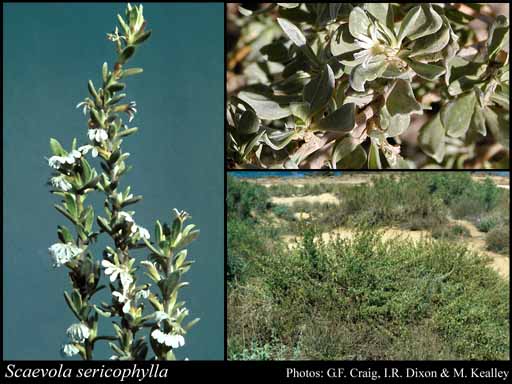- Reference
- Fl.Austral. 4:102-103 (1868)
- Conservation Code
- Not threatened
- Naturalised Status
- Native to Western Australia
- Name Status
- Current
Spreading, dense shrub, 0.2-1.8 m high. Fl. white, Jan to Mar or May or Jul to Oct or Dec. Red or yellow sand. Sandplains & sand dunes.

Scientific Description
Stems unribbed. Leaves flat, 15-25 mm long, 3-10 mm wide, Indumentum present, with dense, simple hairs; margins entire. Bracteoles absent. Pedicel absent (flowers sessile). Calyx lobes present, Calyx length 1.5-2 mm long, hairy, with dense, simple hairs. Corolla white, 16-18 mm long, without auricles, not spurred, hairy on the outside, with dense, simple hairs, hairy on the inside; central lobes 7-9 mm long, with wings; outer lobes 6-8 mm long, wing present on both sides and clearly unequal, 0.5-1 mm wide on the narrower side, 0.8-1 mm wide on the broader side. Anthers free. Ovary inferior, not gibbose; style 8-10 mm long, hairy; indusium single, hairy; ovules one or two. Flowers in January, February, March, April, May, June, July, August, September, October, November and December. Occurs in the Pilbara (PIL), Carnarvon (CAR), Gascoyne (GAS), Great Sandy Desert (GSD), Little Sandy Desert(LSD), Geraldton Sandplains (GS), Swan Coastal Plain (SWA) and Avon Wheatbelt (AW) IBRA Region(s), of the Eremaean (E) and South West (SW) Botanical Province.
Distribution
- IBRA Regions
- Avon Wheatbelt, Carnarvon, Gascoyne, Geraldton Sandplains, Great Sandy Desert, Little Sandy Desert, Pilbara, Swan Coastal Plain, Yalgoo.
- IBRA Subregions
- Ashburton, Augustus, Cape Range, Chichester, Edel, Geraldton Hills, Hamersley, Katanning, Lesueur Sandplain, Mackay, Merredin, Perth, Roebourne, Rudall, Trainor, Wooramel.
- IMCRA Regions
- Pilbara (nearshore).
- Local Government Areas (LGAs)
- Ashburton, Carnamah, Carnarvon, Dandaragan, East Pilbara, Exmouth, Greater Geraldton, Irwin, Karratha, Meekatharra, Moora, Northampton, Shark Bay, Wiluna, Wongan-Ballidu.